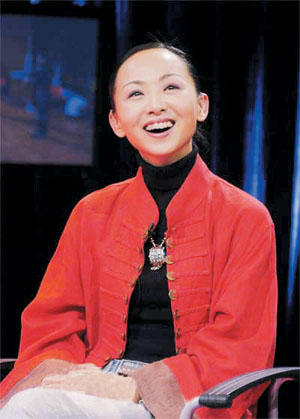Tai Lihua, the disabled lead dancer, was born on November 1976 in Yichang city, Hubei province. After an overdose of streptomycin to treat a high fever at the age of two, Tai began to lose her hearing. She didn't realize this until she tried to join a group of friends in a sound-distinguishing game. She was five by then and other kids were going to normal schools. Tai, thrust in deep depression and solitude, had to go to a primary school for the disabled.

Life had to carry on, but a young heart sobbed on in a soundless world. All until one day when a teacher at the special school brought a drum to class and started to beat it, Tai was thrilled by the rhythmic vibration that passed over her body from under her feet. She was overwhelmed and simply bent over to the wooden floor: It was the most beautiful sound in the world to her.
To again experience such a feeling, Tai would press her little face to a loudspeaker and imagine the dance on TV. It was her language and the only one, to express her understanding of the world. From then on, Tai became obsessed with dancing.
At the age of 15, Tai was selected for professional training. But such a beginner as she was, Tai's movements were so uncoordinated and even a little bit clumsy that the teachers were not positive about her future development.
However, Tai never gave up. Her determination would be physically manifest. During Tai's first summer of dance training, her mother took notice of her daughter's habit of always wearing slacks, never skirts. While Tai napped one day, her mother rolled up a leg of her daughter's trousers. She was shocked to see the severity of the bruising and became distressed to the point of tears.
The Spirit of the Peacock originally by Yang Liping is Tai Lihua's favorite dance. The first time she watched it, she fell in love with it. Lots of dancers tried to emulate Yang's performance and all failed. But after watching Tai's performance, Yang kept saying: "If faced with the same disability, I wouldn't dance it as well as you do."
Tai's outstanding performance brought her to the world stage. She is the only Chinese dancer to have performed both at Carnegie Hall in New York and La Scala in Milan. And a poster of The Spirit of the Peacock by her at Carnegie Hall is the only one from China.
Now when the curtain rises, the lights come up and the music fades in, there is Tai in the elegant flowing dress signature to the piece. She moves with her impressionistic interpretation of that precise-stepping and extraordinary land bird. As if in a silent wood, on a green lawn, or by a gurgling brook, with expression of face and body she captivates with physical interpretation and spirit.
In 1994, Tai was admitted to the Hubei Fine Arts Institute as a stude

nt majoring in decoration and design. Her most loving piece is a canvas painting of ears and eyes. It's about a man standing in an abyss of darkness. She added ears and eyes and also the sun to it because disabled people always aspire for the colorful world. Sunshine brings life and hope.
Tai is always frank and optimistic. If she could hear, she wouldn't get so much care from people around her perhaps, let alone achieve anything. It's the affection that has supported her all along, and so rather than regret, she has great satisfaction.
Thousand-handed Goddess of Mercy, a dance performed by 21 mute and deaf dancers at the evening party held by CCTV at the 2005 Spring Festival, made Tai much more famous throughout China as she was the led of the dance. As Tai understands, the Thousand-handed Goddess of Mercy is kind-hearted and always willing to give a hand to people in difficulty. As the society shows concern and care, the disabled are reaching out with the deepest gratitude.
Tai once told the journalists, “for 20 years we have toured the world to perform. Wherever we have gone, we have been warmly received and highly praised. But, I understand that, without the support of society and help from other artists, I would not have been able to enjoy these days. Our success in our special art is an expression of the Chinese culture, human spirit and social harmony”.